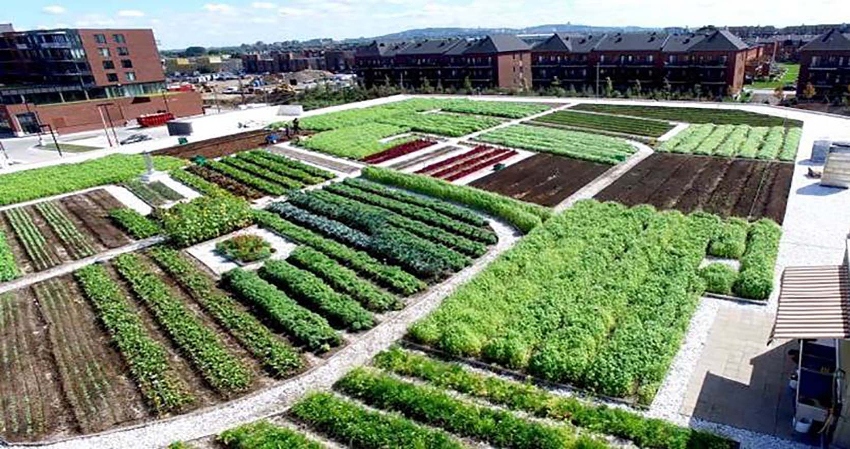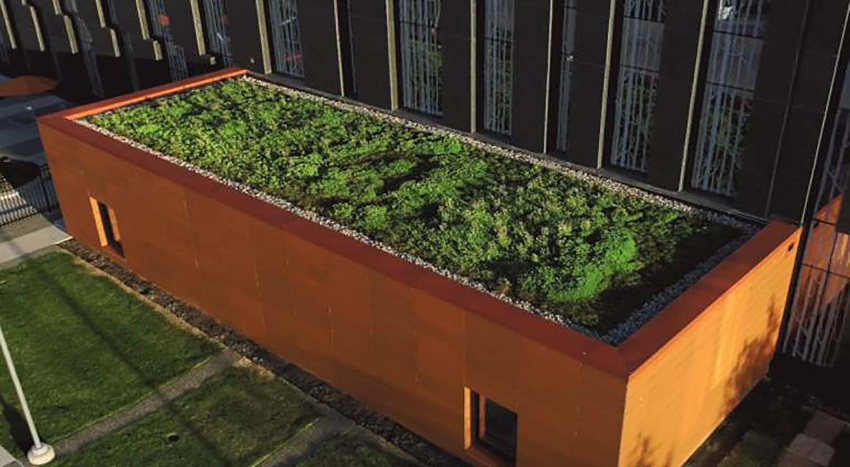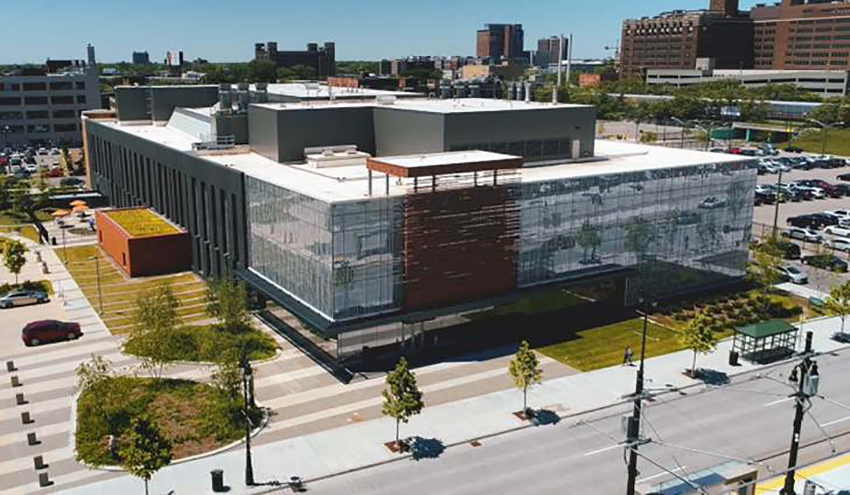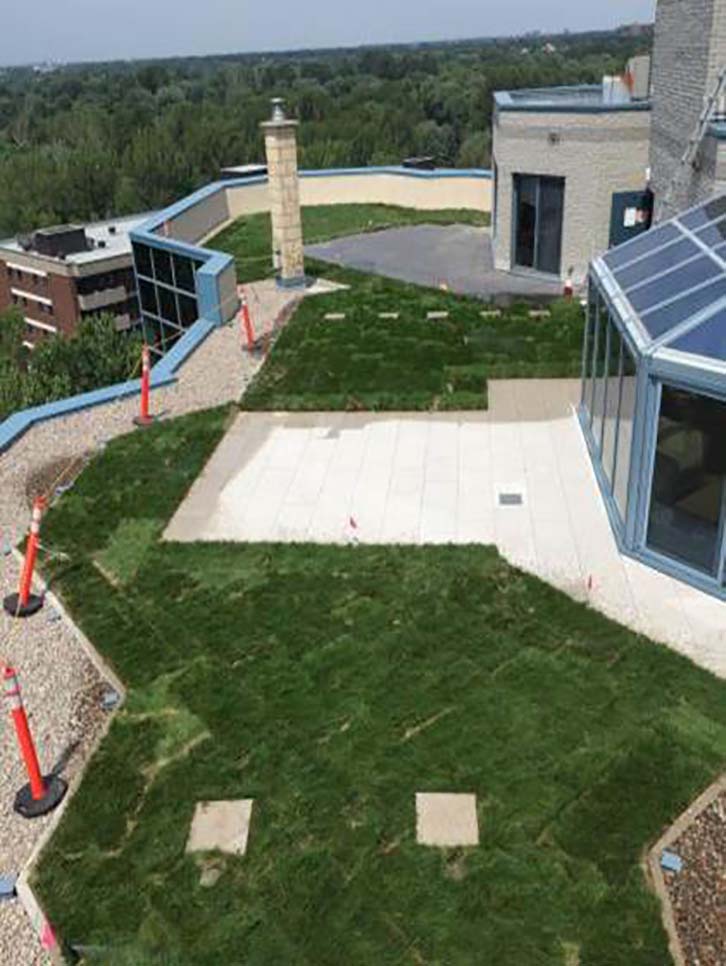Green Roofs: Integrating Blue and Gray into Green
Learning Objectives:
- Identify several types of green roof systems, as well as advantages and disadvantages of these systems with regard to site conditions and project goals.
- Describe the components that make up these systems, the range of options for each component type, and their benefits and drawbacks.
- Explore structural, drainage and waterproofing considerations at transitions between planted and paved areas.
- Employ strategies for integrating planting beds with adjacent hardscapes to maximize water detention and retention in green roofs.
Credits:
Introduction to Green Roofs
When thinking about green roofs, it’s not uncommon to imagine rooftops covered parapet-to-parapet with lush vegetation which will not only protect our rivers by keeping rainwater out of sewers during heavy rains, but also create beautiful outdoor spaces for building occupants.

All photos courtesy of SOPREMA
Building the ideal green roof is not always about maximizing vegetation. It is often about maximizing rainwater storage and functional space that can be enjoyed.
Vegetated roof systems, or green roofs, offer an array of environmental and economic benefits, but they can also be subject to competing goals.
Environmental benefits include rainwater management, urban heat island reduction, and habitat creation, while principal economic benefits include creation of additional usable space, and the ability to charge higher rents. And while rainwater management is rightly considered an environmental benefit, it is also a legal requirement for new construction and many retrofits, and is a major economic driver of green roof demand.
So the two principal economic benefits that green roofs offer are rainwater management and amenity value, but as we’ll discuss later, they don’t always complement each other (although they can).
The vocabulary typically used to describe green roof systems is somewhat limited. Green roof systems are typically described in terms of soil depth (intensive vs. extensive) or where they are assembled (built-in-place vs. modular). These are useful categories, but they do not address key elements of green roof design such as drainage, water storage, roof slope and other considerations. We need to begin thinking more holistically when designing, purchasing and installing green roofs.
This course will give you the background you need to think comprehensively about the needs of your next green roof project, helping you balance vegetation (green) inclusion with water storage (blue) needs and functional hardscape (gray) areas. It will review different green roof systems and components, then cover their use in meeting project goals relating to rainwater management, integration with hardscape and constructability. You will learn how to use blue roof techniques in your green roof and roof deck designs to satisfy rainwater requirements without compromising amenity value.

Figure 1
Urban rooftop farms certainly exist, but roofing systems built with edge-to-edge vegetation make up only a small fraction of green roofs.
Green Roofs: Painting a Realistic Picture
When we think about green roofs we often picture a verdant landscape that pretty much covers the entire roof. We might picture a rooftop farm in a rural setting (or even within an urban environment, such as we see in Figure 1). Roofs that are predominantly green, and therefore create very little runoff, are a small fraction of green roofs in general though. If you look at all buildings that have at least some vegetative cover, the reality is much more complex than our mental pictures of edge-to-edge vegetation would have us believe.

Figure 2
We may picture green roofs looking like this, but we must realize that this is sometimes a part of a much larger picture.
The reality of green roofs has a lot to do with scale. We think of a setup similar to what we see in Figure 2, but we overlook the fact that this is actually just the “little picture.” The “big picture” is shown in Figure 3—where we realize that the “green roof” is only a tiny piece of a much larger building that likely still contributes heavily to rainwater runoff.

Figure 3
Here, you can see that the small green roof from Figure 1 is quite small compared to the overall surface area of the building’s roof.
Rooftop farms which significantly manage rainwater runoff are simply not seen in urban environments very often. A setup more like Figure 3 is more common, with the green roof comprising only a small portion of the total roof.
Just as frequently, vegetated and nonvegetated areas are closely interwoven. Instead of one large planting bed and one large deck, you may have several smaller parcels of “green” and “gray” across the rooftop. In these cases, it is important to know that we can still think of the entire roof as a “green roof,” with potential to store water and control drainage. This is because vegetation is only part of the water management process. Even a green roof designed with lots of “gray,” hardscaped areas can still be an effective rainwater management tool when designed properly.

Vegetation is often interspersed with paved or other hardscaped areas on a green roof, though strong water retention is still possible with the right design.











